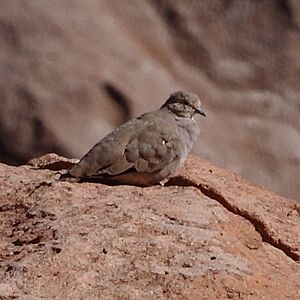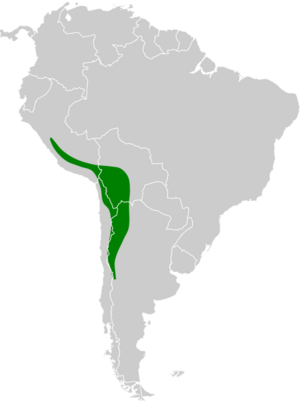Golden-spotted ground dove facts for kids
Quick facts for kids Golden-spotted ground dove |
|
|---|---|
 |
|
| Golden-spotted ground dove at, San Pedro de Atacama, Antofagasta Region, Chile | |
| Conservation status | |
| Scientific classification | |
| Genus: |
Metriopelia
|
| Species: |
aymara
|
 |
|
The golden-spotted ground dove (Metriopelia aymara) is a small bird with cool golden spots on its wings. It's part of the dove and pigeon family, called Columbidae. You can find this special bird in countries like Argentina, Bolivia, Chile, and Peru in South America.
Contents
About the Golden-Spotted Ground Dove
How Scientists Classify It
Scientists group living things into categories. This helps us understand them better. The golden-spotted ground dove is unique. It doesn't have different types or 'subspecies' within its group.
What It Looks Like
Adult golden-spotted ground doves have soft, pale brown feathers on their backs. These feathers often have a hint of reddish pink. Their throat is white, and their belly is a light tan color. The feathers in between are a pretty reddish pink.
Their inner tail feathers are grayish brown with black tips. The outer tail feathers are a purplish black. When their wings are folded, you can see bright, shiny golden spots. These spots are what give the bird its name! There are also two purplish black patches and a dark band at the tips of their flight feathers.
Unlike other doves in its group, this bird's brown eyes are not surrounded by bare skin. Young doves are lighter in color. They have little or no pink and do not have the golden spots on their wings yet.
Where It Lives and What It Likes
The golden-spotted ground dove lives in a wide area of South America. You can find it from central Peru down to Chile's Coquimbo Region and Argentina's Mendoza Province. It prefers dry and semi-dry areas in the Andes mountains. This region is known as the puna zone.
It likes to live on open plains, near lake shores, and among clumps of grass. During nesting season, you might see them in groups in Polylepis woodlands or rocky places. These birds usually live at high elevations, between 2,800 and 5,000 meters (about 9,200 to 16,400 feet) above sea level. However, in the southern parts of its home range, they can be found as low as 300 meters (about 980 feet).
Behavior and Life Cycle
What It Eats
The golden-spotted ground dove finds its food on the ground. It usually feeds in small groups, but sometimes large flocks gather to eat. Scientists haven't studied exactly what this bird eats, so its diet is still a bit of a mystery!
Reproduction and Nests
This dove usually builds its nest in tall grass. However, it might also choose to build a nest in trees or among rocks. Nests with eggs have been found between April and August. Young doves have been seen from July all the way to December. Female doves usually lay two eggs at a time.
Sounds It Makes
Scientists haven't published many details about the sounds the golden-spotted ground dove makes. But one interesting thing is that its wings make a rattling sound when it takes off!
Conservation Status
The IUCN (International Union for Conservation of Nature) has looked at the golden-spotted ground dove. They have assessed it as a species of "Least Concern." This means that it is not currently considered to be in danger of disappearing. It seems to be common in some areas. However, scientists still don't know much about its life and how it interacts with its environment.


